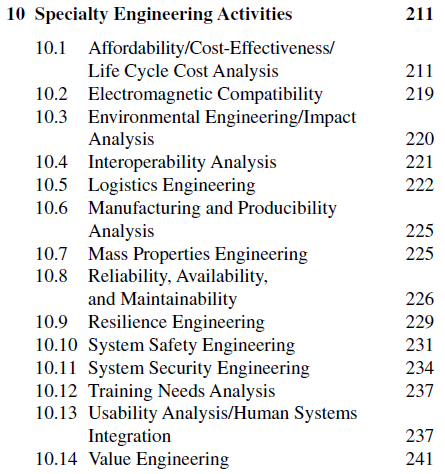Chapter 10 of the INCOSE Systems Engineering Handbook covers “Specialty Engineering”. Take a look at the table of contents below. It’s a hodge-podge of roles and skillsets with varying scope.

There doesn’t seem to be rhyme or reason to this list of items. Training Needs Analysis is a perfect example. There’s no doubt that it’s important, but it’s one rather specific task and not a field unto itself. If you’re going to include this activity, why not its siblings Manpower Analysis and Personnel Analysis?
On the other hand, some of the items in this chapter are supposedly “integral” to the engineering process. This is belied by the fact that they’re shunted into this separate chapter at the end of the handbook. In practice, too, they’re often organized into a separate specialty engineering group within a project.
This isn’t very effective.
Many of these roles really are integral to systems engineering. Their involvement early on in each relevant process ensures proper planning, awareness, and execution. They can’t make this impact if they’re overlooked, which often happens when they’re organizationally separated from the rest of the systems engineering team. By including them in the specialty engineering section along with genuinely tangential tasks, INCOSE has basically stated that these roles are less important to the success of the project.
The solution
The solution is simple: re-evaluate and remove, or at least re-organize, this section of the handbook.
The actual systems engineering roles should be integrated into the rest of the handbook. Most of them already are mentioned throughout the document. The descriptions of each role currently in the specialty engineering section can be moved to the appropriate process section. Human systems integration, for example, might fit into “Technical Management Processes” or “Cross-Cutting Systems Engineering Methods”.
The tangential tasks, such as Training Needs Analysis, should be removed from the handbook altogether. These would be more appropriate as a list of tools and techniques maintained separately online, where it can be updated frequently and cross-referenced with other sources.
Of course, the real impact comes when leaders internalize these changes and organize their programs to effectively integrate these functions. That will come with time and demonstrated success.